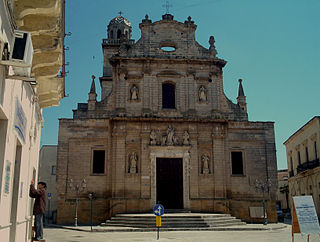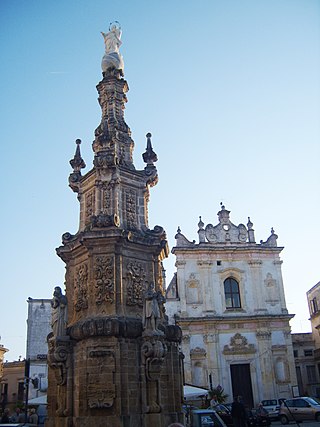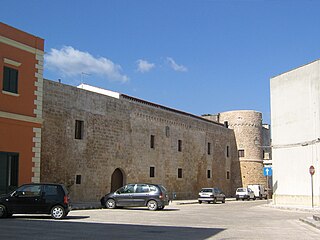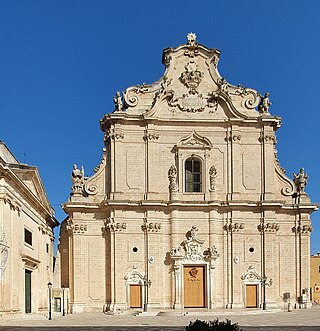
Brindisi is a city in the region of Apulia in southern Italy, the former capital of the province of Brindisi, on the coast of the Adriatic Sea. Historically, the city has played an essential role in trade and culture due to its strategic position on the Italian Peninsula and its natural port on the Adriatic Sea. The city remains a major port for trade with the Balkan Peninsula, Greece and the Middle East. Its industries include agriculture, chemical works, and the generation of electricity.

Lecce is a city in southern Italy and former capital of the province of Lecce, with the second-highest population in the Apulia region. It is on the Salentine Peninsula, at the heel of the Italian Peninsula, and is over two thousand years old.

Salento, is a cultural, historical, and geographic region at the southern end of the administrative region of Apulia, in southern Italy. It is a sub-peninsula of the Italian Peninsula, sometimes described as the "heel" of the Italian "boot". It encompasses the entire administrative area of the Province of Lecce, most of the Province of Brindisi, and the south-eastern part of the Province of Taranto.

Negroamaro is a red wine grape variety native to southern Italy. It is grown almost exclusively in Apulia and particularly in Salento, the peninsula which can be visualised as the "heel" of Italy. The grape can produce wines very deep in color. Wines made from Negroamaro tend to be very rustic in character, combining perfume with an earthy bitterness. The grape produces some of the best red wines of Apulia, particularly when blended with the highly scented Malvasia Nera, as in the case of Salice Salentino.

Grottaglie is a town and comune (municipality) in the province of Taranto, Apulia, in southern Italy.

Salice Salentino is a small town and comune in the southern part of Apulia, Italy, in the Salento area. It is bounded with the province of Taranto to the northwest and the province of Brindisi to the north.

Gallipoli is a southern Italian town and comune in the province of Lecce, in Apulia. In 2014, it had a population of 31,862 and is one of the towns where the Greek dialect Griko is spoken.

San Vito dei Normanni is an Italian town of 19,947 inhabitants of the province of Brindisi in Apulia. The inhabitants are called Sanvitesi and the town is sometimes referred to as San Vito.

Nardò is a town and comune in the southern Italian region of Apulia, in the Province of Lecce.
Carosino is a town and comune in the province of Taranto, in the northern Salento, part of the Apulia region of southeast Italy. Carosino was historically an Arbëreshë settlement. Its economy is based on the production of wine, olive oil and grapes.

San Marzano di San Giuseppe is a town and comune in the Province of Taranto, in the Italian region of Apulia. Alongside Casalvecchio di Puglia and Chieuti, it is one of the Arbëreshë communities still existing in Apulia.

Acquarica del Capo was a town and comune in the province of Lecce, Apulia, south-eastern Italy. In 2019 it was merged with the adjacent Presicce to form Presicce-Acquarica.

Copertino, also known in English as Cupertino, is a town and comune in the province of Lecce in the Apulia region of south-east Italy.

Cutrofiano is a town and comune in the province of Lecce in the Apulia region of south-east Italy. It is known for its shoes and ceramic production.
Miggiano is an Italian city of 3,702 inhabitants in the province of Lecce in Apulia. Located in the lower Salento, a few kilometres from the Adriatic coast, it lies 50 kilometres (31 mi) from the chief town and 22 kilometres (14 mi) from Santa Maria di Leuca. Formerly considered a town, in 2003 Miggiano was elevated to the status of City.
Cesa is a comune (municipality) in the Province of Caserta in the Italian region Campania, located about 15 kilometres (9 mi) north of Naples and about 14 kilometres (9 mi) southwest of Caserta.

Marittima is a hamlet of the Diso municipality in the province of Lecce.

San Lorenzo is a Renaissance-style Roman Catholic parish church located in the town of Civitella del Tronto, in the province of Teramo, Abruzzo, Italy.

Montesardo is a frazione (transl. village) in the comune of Alessano in the province of Lecce in the Apulia region, Italy. As of the 2001 census, it has a population of 1,369. It is 59 km (37 mi) from Lecce, just over 10 km (6.2 mi) from Leuca, and 1 km (0.62 mi) from the comune capital of Alessano.

The Collegiate Basilica of the Most Holy Rosary, also known as the Matrix Church or Cathedral is a Catholic place of worship located in Francavilla Fontana, an Italian municipality in the province of Brindisi in Apulia. It is the largest church in the diocese of Oria, of which it is part, and has the highest dome in Salento, with a diameter of 13 meters.
























